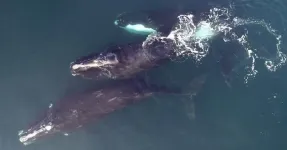(Press-News.org) DURHAM, N.C. – Marine researchers have mapped the density of one of the most endangered large whale species worldwide, the North Atlantic right whale, using newly analyzed data to predict and help avoid whales’ harmful, even fatal, exposure to commercial fishing and vessel strikes.
Duke University’s Marine Geospatial Ecology Lab led a collaboration of 11 institutions in the United States that pooled 17 years of available visual survey data covering 9.7 million square kilometers of the U.S. Atlantic – roughly the same area as the entire contiguous United States.
This information was coupled with auditory data from almost 500 hydrophone recorders in US Atlantic waters that captured whales’ calls. Lining up visual and acoustic datasets for the first time, researchers built a statistical model to estimate the number of whales per square kilometer at different points in time. Researchers published their findings on March 20, 2024 in Marine Ecology Progress Series.
“The more accurate and detailed the mapping, the better chance we have to save dwindling numbers of right whales from preventable injury and fatality,” said Patrick Halpin, director of Duke’s Marine Geospatial Ecology Lab. The lab studies marine ecology, resource management, and ocean conservation, using data to inform ocean management and governance.
Other current real-time efforts to track and protect the whales from deadly encounters with human activities have been incomplete or ineffective. Electronic tagging can harm whale health, and it is infeasible to continuously monitor more than a small fraction of the population that way.
The statistical model is a revision of a 2016 model that predicts whale density from environmental data, like sea surface temperature. This latest version incorporates new data to reflect whales’ changing migration and feeding patterns, including their presence in new areas that lack protection measures for marine life.
“With nearly three times more aerial survey data than we had before, and confirming evidence from the hydrophones, we were able to show how strongly the population has shifted its distribution,” said Jason Roberts, a Duke research associate and lead author of the study.
Right whales maintain the health and balance of marine environments and the entire food web through their feeding habits. As climate change has reduced the population of their prey, whale migration patterns have become more unpredictable, increasing the chances that human activities, like commercial fishing, may harm whale health and chances of reproduction.
Using maps obtained by satellite ocean monitoring, or from physical ocean models like the recently published one, researchers can more accurately predict whale density across the U.S. east coast.
The National Marine Fisheries Service, known as NOAA Fisheries, a federal agency within the National Oceanic and Atmospheric Administration, uses this model to assess and mitigate risks to large whales posed by activities such as trap and pot fishing, vessel traffic, naval testing and training, and offshore energy activities.
This research supports NOAA Fisheries’ overarching North Atlantic Right Whale Road to Recovery, which describes the agency’s efforts to address threats to the species, and monitor recovery progress. In the United States, the Marine Mammal Protection Act prohibits intentional harming or disturbance (known as “takes”) of marine mammals by human activity, and limits takes that happen incidentally.
NOAA Fisheries estimates the number of accidental occurrences of whales harmed, and implements measures to minimize harm. Endangered North Atlantic right whales are approaching extinction. Elevated right whale deaths triggered an Unusual Mortality Event in 2017. In recent years, 125 whales have died or been seriously injured, mostly from entanglements in fishing gear and being struck by vessels in both U.S. and Canadian waters.
NOAA Fisheries and the US Navy co-funded the study.
END
Where have all the right whales gone?
Statistical models, hydrophone network deployed to fight right whale extinction threat
2024-04-12
ELSE PRESS RELEASES FROM THIS DATE:
Researchers find no link between COVID-19 virus and development of asthma in children
2024-04-12
Philadelphia, April 12, 2024 – In the wake of the COVID-19 pandemic, many families worried about the long-term effects posed by the SARS-COV-2 virus. Now, researchers from Children’s Hospital of Philadelphia (CHOP) found that a SARS-COV-2 infection likely does not increase the risk of asthma development in pediatric patients. The findings were published today in the journal Pediatrics.
Respiratory viral infections early in life are risk factors for asthma. Since the SARS-COV-2 virus can cause severe lung inflammation and prolonged respiratory symptoms in certain patients, many families were concerned whether COVID-19 might trigger an asthma diagnosis in their children. CHOP ...
Cell’s ‘garbage disposal’ may have another role: helping neurons near skin sense the environment
2024-04-12
The typical job of the proteasome, the garbage disposal of the cell, is to grind down proteins into smaller bits and recycle some of those bits and parts. That’s still the case, for the most part, but, Johns Hopkins Medicine researchers, studying nerve cells grown in the lab and mice, say that the proteasome’s role may go well beyond that.
Its additional role, say the researchers, may shift from trash sorter to signal messenger in dorsal root ganglion neurons — cells that convey sensory signals from nerve cells close to the skin to the central nervous system.
Results of their experiments, published April 12 in Cell Reports, show that proteasomes may help those specialized ...
Study reveals potential to reverse lung fibrosis using the body’s own healing technique
2024-04-12
he most common type of lung fibrosis — scarring of the lungs -- is idiopathic, meaning of unknown cause.
Researchers are urgently trying to find ways to prevent or slow idiopathic pulmonary fibrosis (IPF) and related lung conditions, which can cause worsening shortness of breath, dry cough, and extreme fatigue. Average survival following diagnosis of IPF is just three to five years, and the disease has no cure.
A recent U-M study from a team led by Sean Fortier, M.D. and Marc Peters-Golden, M.D. of the Division ...
International team co-led by a BSC researcher discovers more than 50 new deep-sea species in one of the most unexplored areas of the planet
2024-04-12
An international group of scientists, co-led by researcher Ariadna Mechó of the Barcelona Supercomputing Center - Centro Nacional de Supercomputación (BSC-CNS), observed 160 species on seamounts off the coast of Chile that had not yet been known to live in the region and suspect that at least 50 of these species are new to science. The recent Schmidt Ocean Institute expedition to the underwater mountains of the Salas y Gómez Ridge, a remote and underexplored area that stretches from ...
Cleveland Innovation District partners exceeding many targets set by state and JobsOhio
2024-04-12
CLEVELAND – Since the Cleveland Innovation District launched in 2021, the founding institutions have made significant progress, including exceeding many of the targets set by the Ohio Department of Development and JobsOhio. Collectively, the institutions participating in this $500 million public-private initiative have created more than 2,600 jobs, spent nearly $1.2 billion on research and innovation, commenced construction of two new research facilities, created dedicated research space comprising more than 550,000 square feet, and awarded more than 7,300 degrees and certificates to support workforce development.
“The Cleveland Innovation District’s progress ...
A third of women experience migraines associated with menstruation, most commonly when premenopausal
2024-04-12
WASHINGTON (April 12, 2024) – A third of the nearly 20 million women who participated in a national health survey report migraines during menstruation, and of them, 11.8 million, or 52.5%, were premenopausal. The analysis was conducted by researchers at Georgetown University Medical Center and Pfizer, Inc., which makes a migraine medication.
Because of the underuse of medications to help treat or prevent menstrual migraines, investigators wanted to understand how common menstrual migraines were and which groups of women could most benefit from potential therapies. The study will be presented April 16, at the American Academy of Neurology ...
MD Anderson Research Highlights for April 12, 2024
2024-04-12
HOUSTON ― The University of Texas MD Anderson Cancer Center’s Research Highlights showcases the latest breakthroughs in cancer care, research and prevention. These advances are made possible through seamless collaboration between MD Anderson’s world-leading clinicians and scientists, bringing discoveries from the lab to the clinic and back.
Recent developments at MD Anderson offer insights into a combination strategy to improve immunotherapy responses, promising trial results for patients with tumors harboring BRAF mutations, a maintenance strategy for patients with acute myeloid leukemia following chemotherapy, a strategy ...
Soft Robotics appoints new Deputy Editor-in-Chief, Barbara Mazzolai, PhD
2024-04-12
Mary Ann Liebert, Inc., is pleased that Barbara Mazzolai, PhD, has been appointed the new Deputy Editor-in-Chief of the bimonthly journal Soft Robotics. Dr. Mazzolai joins Barry Trimmer, PhD, as part of the executive editorial team for the journal.
Soft Robotics is the leading robotics journal devoted to the emerging technologies and developments of soft and deformable robots. The journal’s coverage includes flexible electronics, materials science, computer science, and biomechanics. The journal breaks new ground as the first to answer the urgent need for research on robotic technology that can safely ...
Wiley releases Mass Spectra of Designer Drugs 2024 to accelerate forensics analysis of fentanyls, cannabinoids, and more
2024-04-12
Wiley, one of the world’s largest publishers and a global leader in research and learning, today announced the 2024 release of the Mass Spectra of Designer Drugs.
This indispensable spectral database serves as a cornerstone for forensic laboratories worldwide, enabling swift identification of illicit substances. Sourced from both legal and underground literature, it provides access to the latest novel psychoactive substances (NPS) like variants of fentanyl, xylazine, various opioids, synthetic cannabinoids, and more.
This annually refreshed database provides access to 35,094 mass spectra representing 26,712 unique ...
Freestanding emergency departments are popular, but do they function as intended?
2024-04-12
By Ann Kellett, Texas A&M University School of Public Health
Freestanding emergency departments (EDs) — either satellite branches of hospitals or independently operated facilities — have popped up across the country. Texas has the most, with 338 freestanding EDs as of May 2023, and these facilities handle nearly one quarter of all emergency department visits in the state.
Now, a new study from the Texas A&M University School of Public Health is the first to compare the characteristics of visits to freestanding EDs with visits to traditional hospital-based ...
LAST 30 PRESS RELEASES:
Ribosomal engineering creates “super-probiotic” bacteria
This self-powered eye tracker harnesses energy from blinking and is as comfortable as everyday glasses
Adverse prenatal exposures linked to higher rates of mental health issues, brain changes in adolescents
Restoring mitochondria shows promise for treating chronic nerve pain
Nature study identifies a molecular switch that controls transitions between single-celled and multicellular forms
USU chemists' CRISPR discovery could lead to single diagnostic test for COVID, flu, RSV
Early hominins from Morocco reveal an African lineage near the root of Homo sapiens
Small chimps, big risks: What chimps show us about our own behavior
We finally know how the most common types of planets are created
Thirty-year risk of cardiovascular disease among healthy women according to clinical thresholds of lipoprotein(a)
Yoga for opioid withdrawal and autonomic regulation
Gene therapy ‘switch’ may offer non-addictive pain relief
Study shows your genes determine how fast your DNA mutates with age
Common brain parasite can infect your immune cells. Here's why that's probably OK
International experts connect infections and aging through cellular senescence
An AI–DFT integrated framework accelerates materials discovery and design
Twist to reshape, shift to transform: Bilayer structure enables multifunctional imaging
CUNY Graduate Center and its academic partners awarded more than $1M by Google.org to advance statewide AI education through the Empire AI consortium
Mount Sinai Health system receives $8.5 million NIH grant renewal to advance research on long-term outcomes in children with congenital heart disease
Researchers develop treatment for advanced prostate cancer that could eliminate severe side effects
Keck Medicine of USC names Christian Pass chief financial officer
Inflatable fabric robotic arm picks apples
MD Anderson and SOPHiA GENETICS announce strategic collaboration to accelerate AI-driven precision oncology
Oil residues can travel over 5,000 miles on ocean debris, study finds
Korea University researchers discover that cholesterol-lowering drug can overcome chemotherapy resistance in triple-negative breast cancer
Ushikuvirus: A newly discovered giant virus may offer clues to the origin of life
Boosting the cell’s own cleanup
Movement matters: Light activity led to better survival in diabetes, heart, kidney disease
Method developed to identify best treatment combinations for glioblastoma based on unique cellular targets
Self-guided behavioral app helps children with epilepsy sleep earlier
[Press-News.org] Where have all the right whales gone?Statistical models, hydrophone network deployed to fight right whale extinction threat






